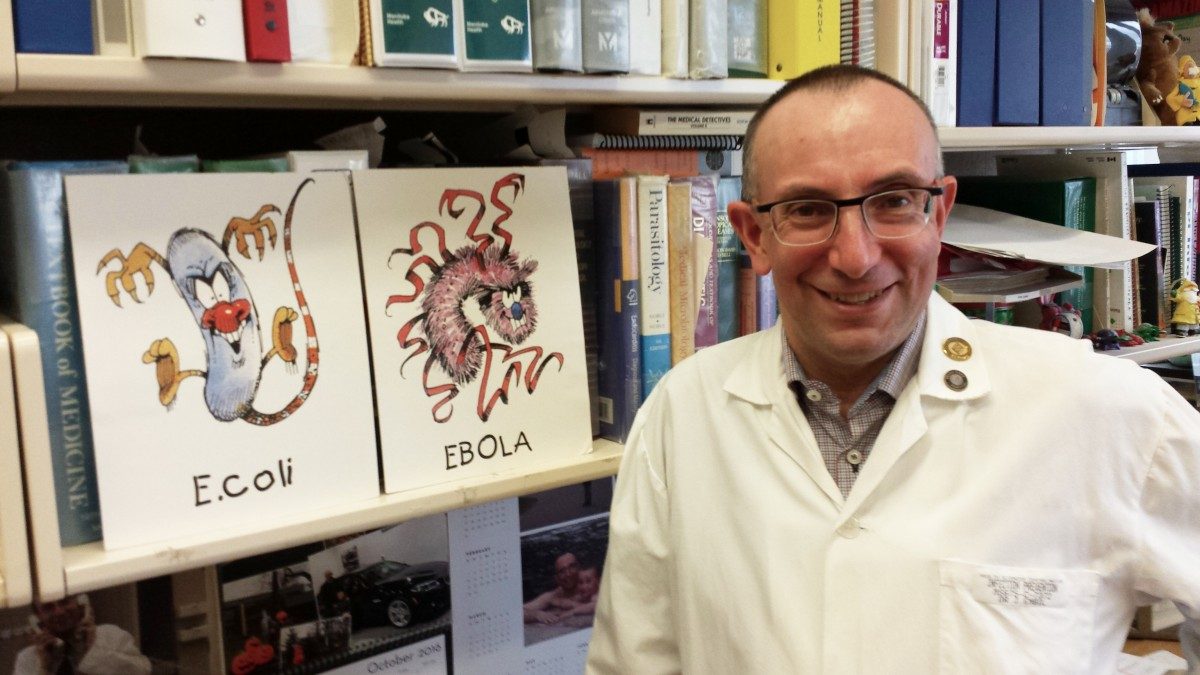
Bug Day’s key organizer, Dr. John Embil.
Bug Day’s popularity still infectious after two decades
Infection can be deadly. But that doesn’t mean learning about it has to be dull.
For 20 years, Manitoba health-care workers have been flocking to Bug Day, an annual day-long program of lively presentations about infection prevention and control, public health and infectious diseases.
The popular event, presented by the Health Sciences Centre in collaboration with Continuing Professional Development – Medicine in the Rady Faculty of Health Sciences, is marking its 20th anniversary on Tuesday, Oct. 18 on the Bannatyne Campus. It’s always held during National Infection Control Week.
Bug Day’s key organizer, Dr. John Embil, has described it as a snapshot of current infection issues, in Manitoba and worldwide.
“What’s unique about Bug Day is that we tie it into a package that has broad appeal. It doesn’t target just physicians, nurses, dentists or physiotherapists. It provides something for all the health sciences,” says Embil, medical director of the infection prevention and control program for HSC and the Winnipeg Regional Health Authority.
Over the years, speakers have shed light on everything from bed bugs to body piercing. The presentations often have irreverent titles, such as Honestly, I Caught it From a Toilet Seat! or Did You Have a Nice Vacation? Let Me Tell You What’s Been Crawling on You!
“There are always take-home points from each speaker, no matter how quirky the topic,” says Embil.
About 1,200 people from diverse health fields attend in person or via MBTelehealth, making Bug Day the largest health-care education event in the province. One of the most memorable presentations in Bug Day history, Embil says, was by Ontario’s Dr. Peter Sarsfield on the topic of mandatory flu vaccinations for health-care workers.
“He finished speaking, and at the microphones people were lined up,” Embil recalls. “Half were fully supportive, and the other half wanted to kill him! It was absolutely outstanding.”
Several of this year’s speakers will discuss the evolution over the past two decades of challenges such as HIV, hantavirus, viral hepatitis and syphilis. Others will focus on foodborne illnesses, germphobia, acute respiratory illness and the Manitoba connection to fighting the Ebola virus.
“All the speakers are doing the ‘looking back, thinking forward’ thing,” says Embil. His own presentation will take a “greatest hits” look back at “everything from SARS to H1N1 to Ebola and Zika; everything from tainted water to contaminated restaurants.”
Bug Day is an accredited continuing professional development event for many health workers. Embil says one of the keys to its success is that “Winnipeggers love free, and Bug Day is completely free.”
Bug Day’s promotional materials, including a 20th-anniversary promo spot featuring rampaging cartoon bugs, reflect Embil’s playful exuberance. He’s so passionate about hand hygiene that he makes occasional appearances in a goofy orange bodysuit as a superhero named Soapy. “Soapy looks like a skinned rat,” Embil says. “There’s something completely ridiculous about him. But it’s stuck. People remember the germ-fighting superhero.”
Still, Soapy’s superpowers have not defeated his nemesis: germs spread by folks who don’t clean their hands. “The most exasperating thing is when we see our audit data for hand cleaning (by health workers in Winnipeg) and we still have not been able to achieve the desired 80 per cent compliance,” he says.
“We’re all in this together. If anyone falls down, it lets the whole group down.”







I can’t figure how to get the video up and running with sound, Help